Last Updated on May 30, 2024 by teamobn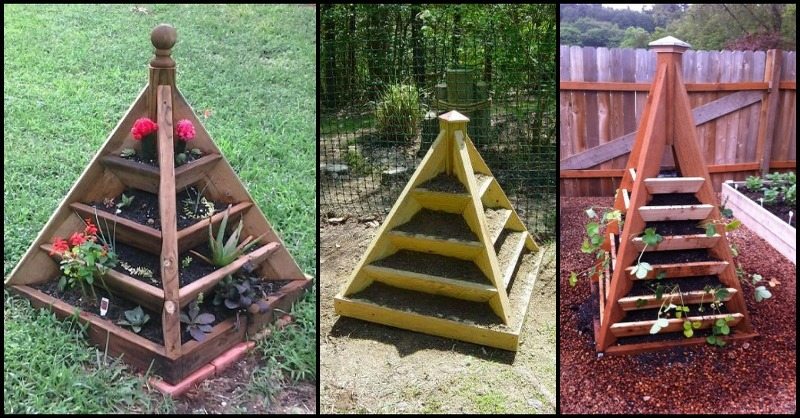
The finest strawberries you’ll ever taste will have to come from your own orchard because fully ripened strawberries you’ve grown will taste sweeter and juicier than any store-bought fruit. You can easily grow these fruits with your own strawberry pyramid planter.
Nothing compares to biting into a sun-warmed strawberry that’s been picked at the peak of ripeness and eating it right then and there. The experience is truly magical and something that you’ll never forget.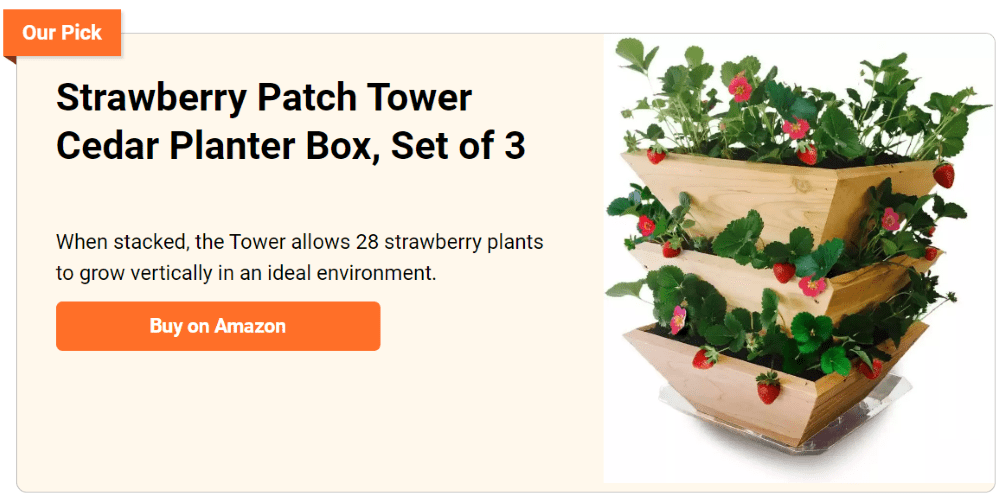
Strawberries are one of the easiest fruits to grow at home, but they can take up a lot of room when planted in a traditional “strawberry patch”. You need to give strawberries room for runners by planting them 18 inches apart.
That entails a considerable amount of space if you intend to grow even just a handful of plants. But there are ways to grow strawberries in a smaller space by using creative pots and containers.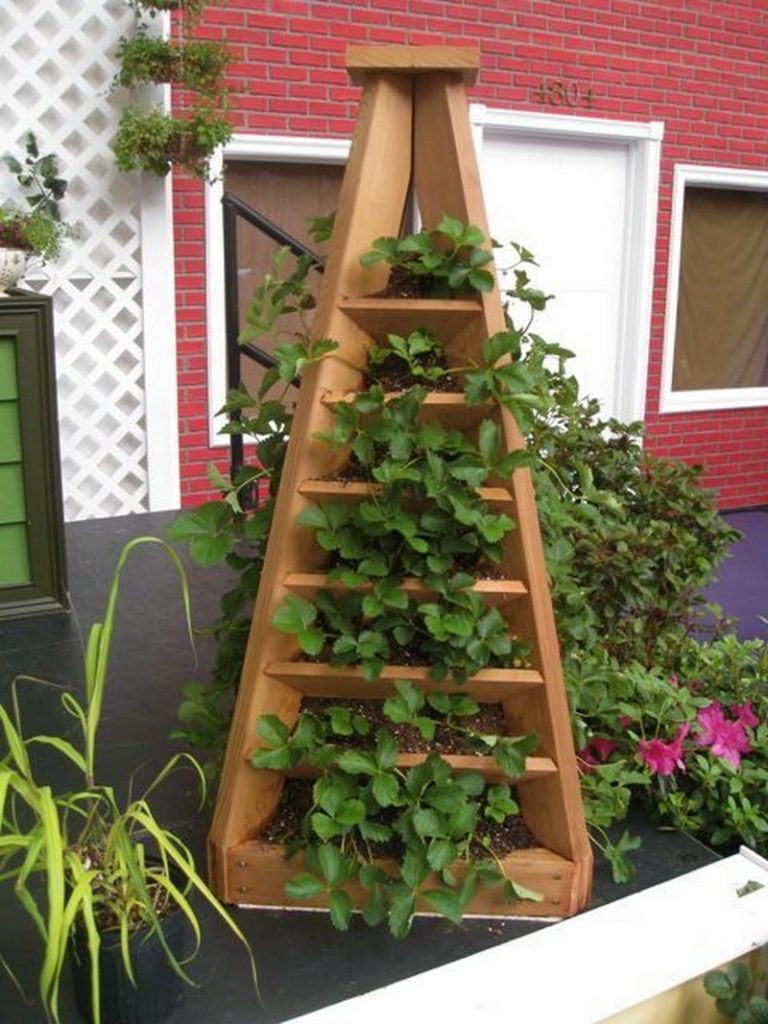
This project will give you homegrown strawberries while taking up only a fraction of the space of a typical garden. A pyramid planter is an ideal way of growing a great quantity of garden produce in a limited garden space.
This is a great project for those who want to enjoy fresh strawberries but don’t have a lot of space to dedicate to a traditional garden.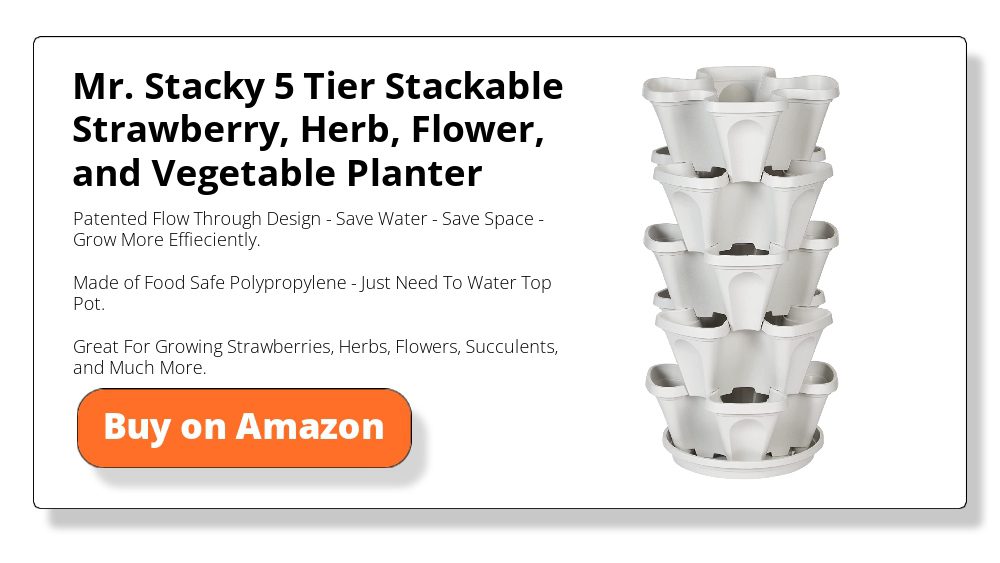
The strawberry pyramid planters are easy and inexpensive to build, especially when made from leftover timber from your previous projects. This project should only take you a weekend to finish, as long as you have all the materials and tools needed.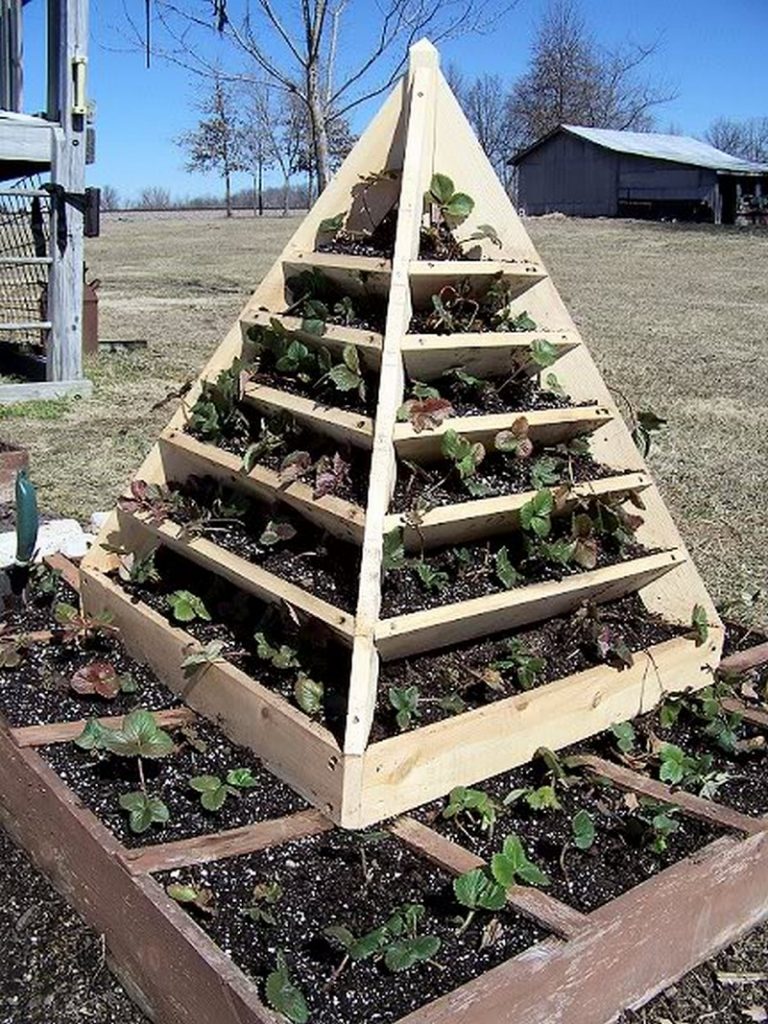
Materials needed to build your own strawberry pyramid planters:
- 1 – 4″ X 4″ X 6′ Cedar Wood – for main centre post
- 11 – 1″ X 4″ X 8′ Cedar Wood – for structure
- 1 – 3′ X 3′ Plywood – for base
- 1 – 2″ X 2″ X 8′ Cedar Wood – for top
- 4 – Wheel Casters
- 75 – 1 1/2″ Deck Screws
- Wood Glue
- Gravel
- Dirt
- Varnish
- Wood Glue
- Drill
- Table Saw
- Clamps
- Brush
How to build your own strawberry pyramid planters?
1. Cut the timber into equal pieces.
- If you want your pyramid planter to turn out perfectly, you’ll need to make sure that you cut your timber into three equal pieces, each length. This is a crucial step in the process, so don’t skip it!
2. Screw the board together.
- Drill holes into the boards, making sure that the holes are big enough for the screws. Then, screw the pieces of timber together at the corners to form a pyramid shape.
- Be sure to leave a gap at the top of the pyramid, as this will be where you insert the final piece of timber, forming the point of the pyramid.
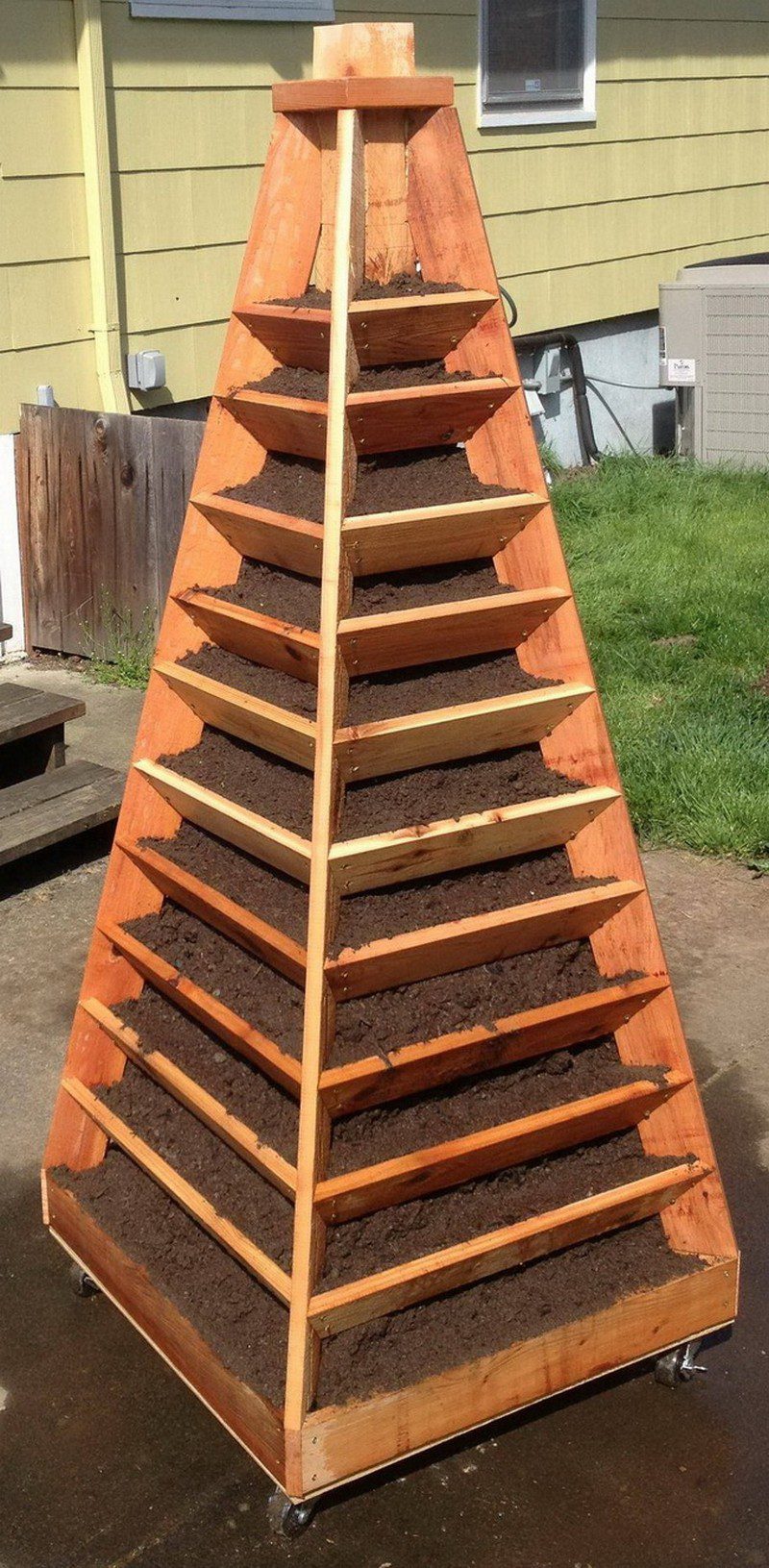
3. Drill holes in the sides of the pyramid planters for drainage.
- You’ll need to drill some holes in the sides. This will allow any excess water to drain out, preventing your plants from becoming waterlogged.
- To do this, simply use a drill with a bit that’s the right size for the holes you need. Start at the top of the pyramid and work your way down, drilling a few holes in each row.
4. Finally, fill the pyramid with soil and plant your strawberries.
- Make sure to compact the soil around the plants so that they are secure, and water them well. You may want to add a layer of mulch to help retain moisture and keep the strawberries clean.
If you’re looking for a fun and rewarding gardening project, why not try growing strawberries?
Strawberries are relatively easy to grow, and they make a delicious and healthy addition to your diet. Plus, there’s nothing quite like the taste of freshly picked strawberries from your own garden.
Amazing DIY Strawberry pyramid planter designs
Click on any image to start the lightbox display. Use your Esc key to close the lightbox. You can also view the images as a slideshow if you prefer 😎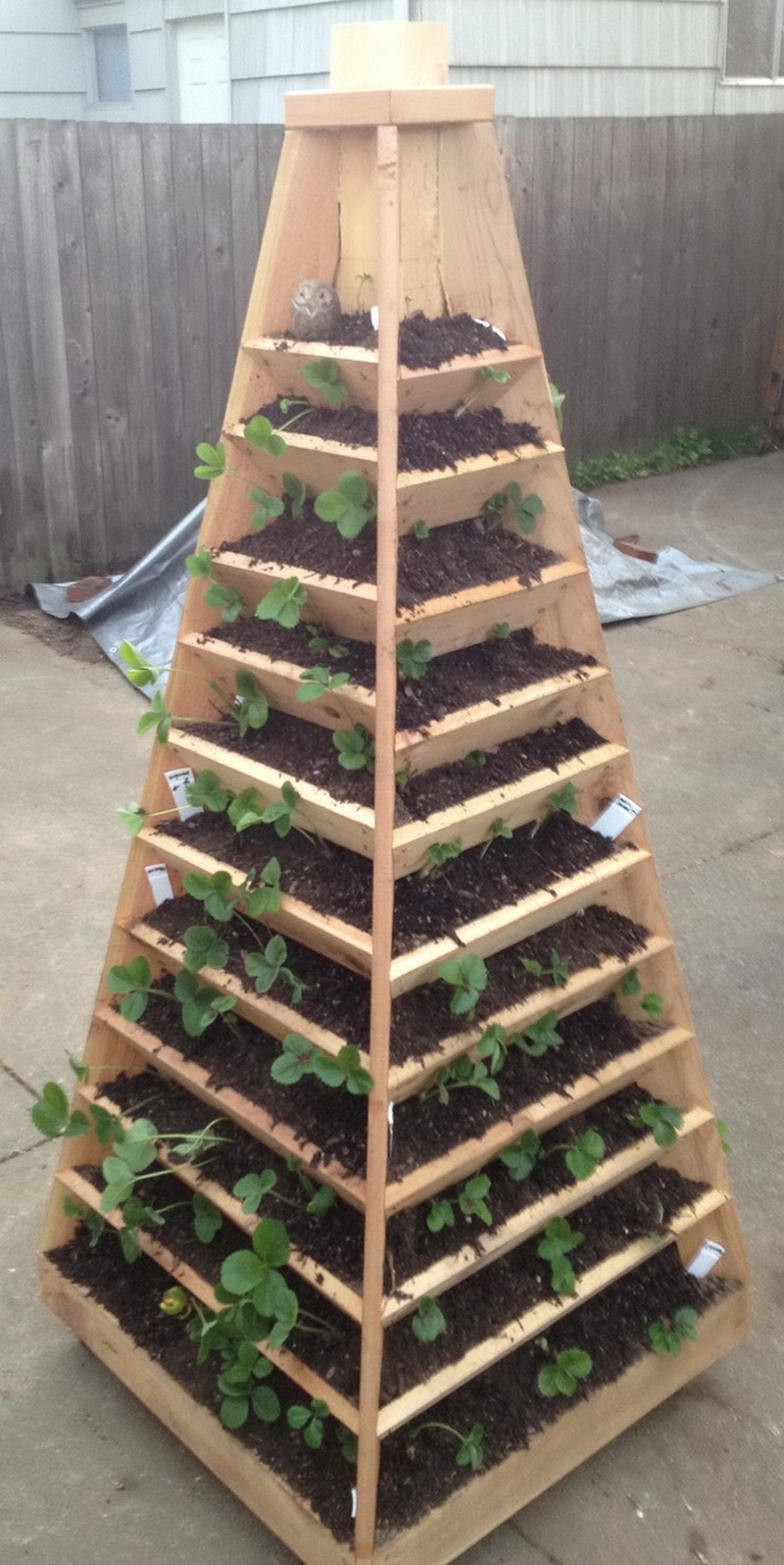


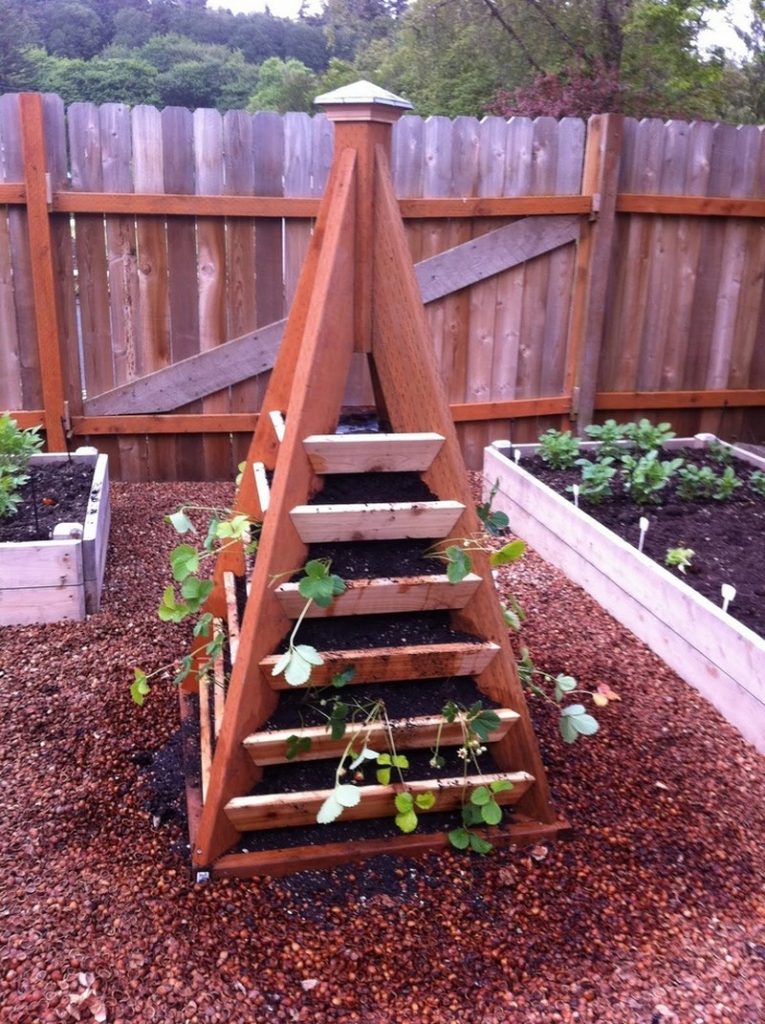

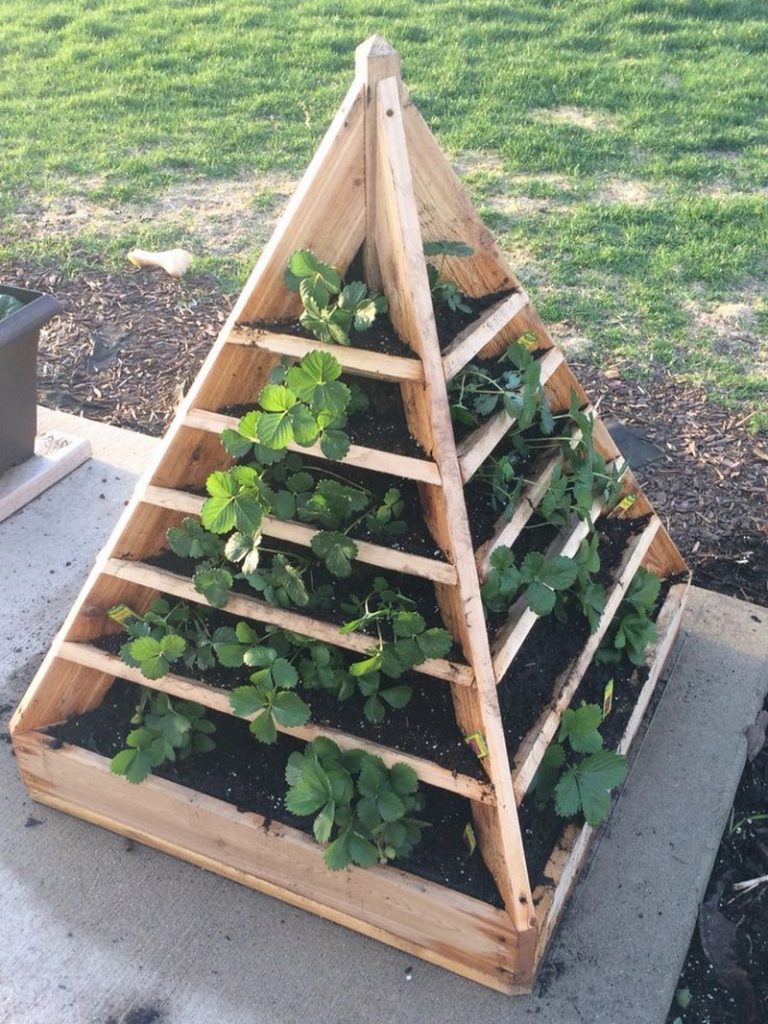
Benefits of Growing Strawberries in Pyramid Planters
Growing strawberries in pyramid planters offers several benefits. These unique structures are visually appealing and practical for gardeners with limited space. Below are the key advantages of using a strawberry pyramid planter.
Space Efficiency
Pyramid planters are a game-changer for those with limited gardening space. They are especially suited for small gardens, balconies, or patios. Their vertical design is a smart way to grow strawberries, making the most of upward space rather than spreading outwards. This means you can cultivate many strawberry plants in a compact area.
The tiered levels of a pyramid planter provide ample growing room. Each level can host several strawberry plants, multiplying the growing space vertically. This starkly contrasts traditional flatbed gardening, which requires much more horizontal space to achieve the same plant density.
Urban gardeners often face the challenge of limited outdoor space. A strawberry pyramid planter is an ideal solution. It allows city dwellers to enjoy fresh, home-grown strawberries without needing a large garden. This design saves space and adds a unique aesthetic to urban balconies or rooftops, blending functionality with visual appeal.
Adopting this vertical gardening approach allows you to grow an abundant strawberry crop in a fraction of the space required by traditional methods. This makes strawberry pyramid planters practical and efficient for maximizing limited gardening areas.
Improved Plant Health
Growing strawberries in pyramid planters significantly enhances their health and vitality. These planters are designed to provide optimal conditions for strawberry growth, leading to healthier plants and a more fruitful harvest.
The open, tiered structure of pyramid planters allows for superior air circulation around the strawberry plants. This airflow is crucial in preventing the buildup of moisture and humidity around the leaves and fruit, which often lead to fungal diseases. Better air circulation also contributes to more robust and faster plant growth.
In addition to improved airflow, pyramid planters offer better exposure to sunlight. Each tier receives ample sunlight, ensuring all plants, even those at the bottom, get the light they need. This consistent and even exposure is key to developing strong, healthy strawberry plants. Sunlight is essential for photosynthesis, which fuels plant growth and fruit production.
Another significant advantage of using a pyramid planter is the elevated design, which keeps strawberry fruits off the ground. This is crucial in minimizing the risk of soil-borne diseases and fungal infections, such as gray mold or powdery mildew, common in strawberries that rest on or near the soil.
Elevating the strawberries also helps in pest management. Strawberries grown on the ground are more susceptible to pests like slugs and snails. A pyramid planter reduces the chances of these and other pests reaching the fruits, leading to a healthier and cleaner harvest.
Easy Accessibility
The design of strawberry pyramid planters offers a significant advantage in terms of accessibility, making the care and harvesting of strawberries much more convenient and comfortable.
One of the primary benefits of a pyramid planter is the ease of harvesting. The tiered structure means strawberries grow at different heights, reducing the need to bend or kneel excessively. This is particularly beneficial for individuals with back problems or mobility issues. You can easily reach the strawberries at each level, making the harvesting process less physically demanding and more enjoyable.
The accessibility of pyramid planters also makes them ideal for older gardeners or those with limited mobility. They can continue gardening without the strain associated with traditional ground-level beds. This inclusive design ensures everyone can experience the joy and satisfaction of growing their strawberries.
In addition to making harvesting easier, pyramid planters simplify the monitoring and maintenance of strawberry plants. The elevated and open design provides a clear view of all plants. This visibility makes it easier to spot issues such as pest infestations, diseases, or nutrient deficiencies early on. Early detection is key to addressing these problems promptly and effectively, ensuring the health and productivity of the strawberry plants.
The tiered structure facilitates easier access for routine maintenance tasks like pruning, fertilizing, and watering. You can reach each plant without stretching or disturbing other plants, as is often the case in traditional row planting. This ease of access not only makes caring for the plants more straightforward but also more efficient.
Incorporating a strawberry pyramid planter into your garden can transform your strawberry growing experience. It’s efficient, promotes healthy growth, and makes tending to your berries a delight.
Alternative Materials for Building a Pyramid Planter
When building a strawberry pyramid planter, you can consider several alternative materials. These options offer sustainability and add a unique touch to your garden. Let’s explore some creative materials you can use to construct your strawberry pyramid planter.
Recycled Wood
Recycled or reclaimed wood is a great eco-friendly option for building a strawberry pyramid planter. Look for old pallets, discarded wooden furniture, or leftover wood from previous projects. Not only does this help reduce waste, but it also gives your strawberry pyramid planter a rustic, charming look.
Plastic Barrels
Used plastic barrels can be transformed into an efficient strawberry pyramid planter. Cut the barrels into tiered sections and stack them to create a pyramid shape. This is a cost-effective and durable option. Plus, it’s a great way to repurpose materials that would otherwise end up in a landfill.
Metal Containers
Consider using metal containers or sheets to build your strawberry pyramid planter for a modern twist. Galvanized steel or aluminum can provide a sleek look. Ensure the metal is safe for gardening and has proper drainage. Metal planters are durable and can add a contemporary feel to your garden space.
Concrete Blocks
Concrete blocks can create a sturdy and long-lasting strawberry pyramid planter. Arrange the blocks in a tiered pyramid shape and fill the cavities with soil. This material is excellent for maintaining moisture balance and adds an industrial aesthetic to your garden.
Terracotta Pots
Terracotta pots can be an attractive choice for a smaller strawberry pyramid planter. Stack the pots in descending size order to create a mini pyramid. This is perfect for balconies or small patios and adds a Mediterranean feel to your gardening space.
Old Tires
Repurposing old tires into a strawberry pyramid planter is another innovative approach. Paint them in vibrant colors and stack them to form a pyramid. This method is resourceful and adds a playful touch to your garden.
Using alternative materials to build your strawberry pyramid planter can be environmentally friendly and creatively fulfilling. These options allow you to customize your planter to fit the aesthetics of your space while contributing to sustainability.
Harvesting and Using Your Strawberries from a Pyramid Planter
Harvesting strawberries from your strawberry pyramid planter is a rewarding experience. Not only do you get to enjoy the fruits of your labor, but you also have the opportunity to use these fresh strawberries in various delicious ways. Here’s how to make the most out of your strawberry harvest.
When to Harvest Strawberries
The timing of harvesting strawberries from your strawberry pyramid planter is crucial for flavor and quality. The ideal moment is when they have fully matured to a bright red color. These ripe berries will be firm yet slightly soft, indicating peak sweetness and juiciness.
Identifying Ripe Strawberries
Look for uniform redness, as strawberries do not ripen further once picked. The size can vary, but the color is your best indicator of ripeness. Avoid berries with green or white areas, as they might still be underripe.
Harvesting Technique
When harvesting, be gentle to avoid bruising the fruit. The best method is gently twisting the berries off the stem or using scissors to snip them. This minimizes damage to both the fruit and the plant. Early morning is the best time to pick strawberries, as the cooler temperature preserves their natural sugars and extends their shelf life.
Storing Your Harvest
Proper storage is key to maintaining the freshness of strawberries harvested from your pyramid planter. If not used immediately, it’s important to store them in a way that preserves their flavor and texture.
Refrigeration
For short-term storage, place the strawberries in the refrigerator. Keep them in a breathable container, like a perforated plastic bag, to prevent excess moisture accumulation. Avoid washing the berries before refrigeration, as the added moisture can hasten spoilage.
Freezing for Longevity
For long-term storage, freezing strawberries is an effective option. First, wash and hull them, removing the green leafy caps. Pat them dry to remove excess moisture. Arrange the strawberries in a single layer on a baking sheet and freeze them until solid. Once frozen, transfer them to a freezer-safe bag. This method prevents the strawberries from sticking together, allowing you to use individual berries as needed.
Fresh Strawberry Recipes
Your freshly picked strawberries from the strawberry pyramid planter are perfect for various recipes. Use them in smoothies, salads, or desserts like strawberry shortcakes and pies. Fresh strawberries also make delicious homemade jams and preserves.
Strawberry Health Benefits
Strawberries from your pyramid planter are not just tasty; they’re also packed with vitamins and antioxidants. Incorporate them into your diet to enjoy their health benefits. They’re great in breakfast dishes, as a healthy snack, or added to yogurt and cereal.
Harvesting and using strawberries from your pyramid planter is a delightful experience. These fresh, homegrown berries can be used in various culinary creations and are a healthy addition to your diet. Enjoy the fruits of your strawberry pyramid planter in many delicious and nutritious ways.
FAQ on Strawberry Pyramid Planter
What is a strawberry pyramid planter?
How many strawberry plants can I grow in a pyramid planter?
What types of strawberries are best for a pyramid planter?
How do I water my strawberry pyramid planter?
Can I build a strawberry pyramid planter with recycled materials?
When is the best time to plant strawberries in the planter?
How do I protect my strawberries from pests?
Can I grow other plants in my strawberry pyramid planter?
How often should I replace the soil in my pyramid planter?
How long does a strawberry plant last in a pyramid planter?
Conclusion
Growing strawberries in a pyramid planter is an innovative and efficient way to enjoy homegrown fruits. These planters offer space efficiency, improved plant health, and easy accessibility, making them ideal for gardeners of all levels. With proper care, harvesting, and storage, your planter will provide a bountiful supply of fresh strawberries.






